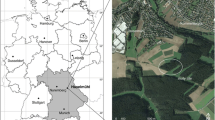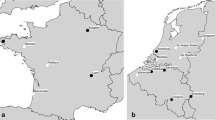Abstract
The article presents the results of long-term observations of variations in the abundance of Ixodes persulcatus, carried out since 1982, in the middle taiga subzone of Karelia. Adult questing ticks were collected from vegetation following standard flagging procedures. The time series was evaluated by singular spectrum analysis. Correlation coefficients were calculated for the observed tick abundances and meteorological data (mean daily air temperature and precipitation) for the current year and preceding years. Analysis of the time series revealed the trend and harmonic components with periods of 8, 2.5 and 4 years. Around 83% of the total variance is explained by the first principal component, which governs the general vector of change—a gradual reduction in I. persulcatus abundance from 2003 to 2017. Correlations between tick abundance and climatic indices were observed in all years and were associated with both temperature and precipitation. The greatest number of significant coefficients was obtained for correlations between tick abundance and weather conditions in the preceding season. An equation was suggested where tick abundance is described by a linear function with four variables: mean air temperature in April and July, total precipitation in February, and annual number of days with temperatures above 5 °С. Thus, the observed long-term dynamics are characterized by the following key patterns: a sharp population rise early in the 2000s, some recent decline (stabilization) of the abundance, the presence of quasi-periodic cycles, and a close correlation between tick abundance and climatic variables.





Similar content being viewed by others
References
Bespyatova LA, Bugmyrin SV (2015) Ixodid ticks (Parasitiformes: Ixodidae) from small mammals in reforesting boreal habitats of the northern European Russia. Entomol Rev 95:1308–1316. https://doi.org/10.1134/S0013873815090183
Bobrovskikh TK (1989) Ixodid ticks (Subfamily Ixodinae) in Karelia. Karelian branch of AS USSR, Petrozavodsk (in Russian)
Bugmyrin SV, Bespyatova LA, Anikanova VS, Ieshko EP (2010) Abundance of larvae and nymphs of the taiga tick Ixodes persulcatus Schulze (Acarina, Ixodidae) on small mammals in deforested areas in the middle taiga subzone of Karelia. Entomol Rev 90:116–122. https://doi.org/10.1134/S0013873810010094
Bugmyrin SV, Bespyatova LA, Korotkov YS, Burenkova LA, Belova OA, Romanova LI, Kozlovskaya LI, Karganova GG, Ieshko EP (2013) Distribution of Ixodes ricinus and I. persulcatus ticks in southern Karelia (Russia). Ticks Tick-borne Dis 4:57–62. https://doi.org/10.1016/j.ttbdis.2012.07.004
Bulygina ON, Razuvaev VN, Aleksandrova TM (2018) Description of the mass data of air daily temperature and number of sediments at meteorological stations of Russia and the former USSR (TTTR). http://meteo.ru/data/162-temperature-precipitation#описание-массива-данных; http://aisori.meteo.ru/ClimateR. Accessed 30 Jan 2018 (in Russian)
Burenkova LA (2012) Results of 20-year observations of changes in the site of an Ixodes ricinus (Acari: Ixodes) population and a change in its infection with tick-borne borreliosis pathogens in the north of the Kaluga region. Meditsinskaya Parazitologia i Parazitarnye Bolezni 4:30–32 (in Russian)
Golyandina N, Nekrutkin V, Zhigljavsky A (2001) Analysis of time series structure: SSA and related techniques. Chapman & Hall/CRC, New York
Grigoryeva LA (2015) Peculiarities of taiga tick Ixodes persulcatus Sch. (Parasitiformes: Ixodidae) development in natural biotopes in Leningrad Province. Proc Zool Inst 319:269–281 (in Russian)
Grigoryeva LA, Stanyukovich MK (2016) Life cycle of the taiga tick Ixodes persulcatus (Acari: Ixodidae) in the North-West of Russia. Exp Appl Acarol 69:347–357. https://doi.org/10.1007/s10493-016-0038-1
Guseva TL, Korosov AV, Bespyatova LA, Anikanova VS (2014) Long-term dynamics of biotopical distribution of a common shrew (Sorex araneus Linnaeus 1758) in Karelian mosaic landscape. Proc Petrozavodsk State Univ 145:13–20 (in Russian)
Hassani H (2007) Singular spectrum analysis: methodology and comparison. J Data Sci 5:239–257
Hassani H, Zhigljavsky A (2009) Singular spectrum analysis: methodology and application to economics data. J Syst Sci Complex 22:372–394
Hudson IL, Keatley MR (2010) Singular spectrum analysis: climatic niche identification. In: Hudson I, Keatley M (eds) Phenological research. Springer, Dordrecht, pp 393–424. https://doi.org/10.1007/978-90-481-3335-2_18
Hvidsten D, Stuen S, Jenkins A, Dienus O, Olsen RS, Kristiansen B-E, Mehl R, Matussek A (2014) Ixodes ricinus and Borrelia prevalence at the Arctic Circle in Norway. Ticks Tick-borne Dis 5:107–112. https://doi.org/10.1016/j.ttbdis.2013.09.003
Jaenson TGT, Jaenson DGE, Eisen L, Petersson E, Lindgren E (2012) Changes in the geographical distribution and abundance of the tick Ixodes ricinus during the past 30 years in Sweden. Parasites Vector 5:8. https://doi.org/10.1186/1756-3305-5-8
Jaenson TGT, Värv K, Fröjdman I, Jääskeläinen A, Rundgren K, Versteirt V, Estrada-Peña A, Medlock JM, Golovljova I (2016) First evidence of established populations of the taiga tick Ixodes persulcatus (Acari: Ixodidae) in Sweden. Parasites Vector 9:377. https://doi.org/10.1186/s13071-016-1658-3
Jore S, Vanwambeke SO, Viljugrein H, Isaksen K, Kristoffersen AB, Woldehiwet Z, Johansen B, Brun E, Brun-Hansen H, Westermann S, Larsen I-L, Ytrehus B, Hofshagen M (2014) Climate and environmental change drives Ixodes ricinus geographical expansion at the northern range margin. Parasites Vector 7:11. https://doi.org/10.1186/1756-3305-7-11
Kazantseva TI, Adamovich BV, Alimov AF, Zhukova TV, Solntsev VN (2018) Singular spectrum analysis of hydroecological parameter dynamics of lake Naroch’ in the years 1978–2015. Rus J Ecol 49:1–13. https://doi.org/10.1134/S1067413618010071
Kheisin EM, Pavlovskaya OE, Malakhova RP, Rybak VF (1955) Duration of the life cycle of Ixodes persulcatus in natural conditions of Karelo-Finnish SSR. Proc Karelian-Finnish State Univ 6:102–123 (in Russian)
Korotkov YuS (1998) Cyclic processes in the dynamic of Ixodes persulcatus number (Acarina: Ixodidae) and their relation to weather and climatic conditions. Parazitologiya 32:21–31 (in Russian)
Korotkov YuS, Volchkova GA, Kislenko GS, Chunikhin SP, Shmakov LV (1989) Cyclic changes in Ixodes persulcatus number in Udmurtia. Meditsinskaya Parazitologia i Parazitarnye Bolezni 1:65–69 (in Russian)
Korotkov YuS, Belkin VV, Bespyatova LA, Bugmyrin SV (2010) Paradoxes in conceptions of hosts’ role in tick dynamics (by example of the taiga tick). Pest Manag 76:16–21 (in Russian)
Korotkov Yu, Kozlova T, Kozlovskaya L (2015) Observations on changes in abundance of questing Ixodes ricinus, castor bean tick, over a 35-year period in the eastern part of its range (Russia, Tula region). Med Vet Entomol 29:129–136. https://doi.org/10.1111/mve.12101
Laaksonen M, Sajanti E, Sormunen JJ, Penttinen R, Hänninen J, Ruohomäki K, Sääksjärvi I, Vesterinen EJ, Vuorinen I, Hytönen J, Klemola T (2017) Crowd sourcing-based nationwide tick collection reveals the distribution of Ixodes ricinus and I. persulcatus and associated pathogens in Finland. Emerg Microbes Infec 6:e31. https://doi.org/10.1038/emi.2017.17
Levakin IA, Nikolaev NE, Galaktionov КV (2013a) A case study of singular spectrum analysis application in parasitology: dynamics of prevalence of Cryptocotyle concavum and Bunocotylepro genetica trematode parthenitae in Hydrobia ventrosa snails at the White Sea. Parazitologiya 47:23–37 (in Russian)
Levakin IA, Nikolaev KE, Galaktionov KV (2013b) Long-term variation in trematode (Trematoda, Digenea) component communities associated with intertidal gastropods is linked to abundance of final hosts. Hydrobiologia 706:103–118. https://doi.org/10.1007/s10750-012-1267-x
Okulova NM, Scadinya ЕА, Bobrovskikh ТК (2001) Factors affecting the abundance of the taiga tick Ixodes persulcatus Sch. in north-western part of its area. Acarina 9:167–174
Osipova TN, Grigoryeva LA, Samoylova EP, Shapar AO, Bychkova EM (2017) The influence of meteorological factors on the activity of adult taiga ticks (Ixodes persulcatus Sch., Ixodinae) in St. Petersburg and its environs. Entomol Rev 97:554–563. https://doi.org/10.1134/S0013873817040169
Porretta D, Mastrantonio V, Amendolia S, Gaiarsa S, Epis S, Genchi C, Bandi C, Otranto D, Urbanelli S (2013) Effects of global changes on the climatic niche of the tick Ixodes ricinus inferred by species distribution modelling. Parasites Vector 6:271. https://doi.org/10.1186/1756-3305-6-271
Shashina NI (1985) Total duration of life cycle. In: Filippova NA (ed) Taiga Tick Ixodes persulcatus Schulze (Acarina, Ixodidae). Nauka, Leningrad, pp 275–277 (in Russian)
Sirotkin MB, Korenberg EI (2018) Influence of abiotic factors on different developmental stages of the taiga (Ixodes persulcatus) and European forest (Ixodes ricinus) ticks. Entomol Rev 98:496–513. https://doi.org/10.1134/S0013873818040115
Tokarevich NK, Tronin AA, Blinova OV, Buzinov RV, Boltenkov VP, Yurasova ED, Nurse J (2011) The impact of climate change on the expansion of Ixodes persulcatus habitat and the incidence of tick borne encephalitis in the north of European Russia. Glob Health Action 4:1. https://doi.org/10.3402/gha.v4i0.8448
Tokarevich N, Tronin A, Gnativ B, Revich B, Blinova O, Evengard B (2017) Impact of air temperature variation on the ixodid ticks habitat and tick-borne encephalitis incidence in the Russian Arctic: the case of the Komi Republic. Int J Circumpol Heal 76:1. https://doi.org/10.1080/22423982.2017.1298882
Williams HW, Cross DE, Crump HL, Drost CJ, Thomas CJ (2015) Climate suitability for European ticks: assessing species distribution models against null models and projection under AR5 climate. Parasites Vector 8:440. https://doi.org/10.1186/s13071-015-1046-4
Yamborko AV, Tretyakov KA, Muravyova VP (2015) The first findings of Ixodes persulcatus (Acarina, Ixodidae) in Magadan Province. Entomol Rev 95:666–671. https://doi.org/10.1134/S0013873815050103
Zotin AA, Ieshko EP (2016) Irregularity of the linear growth of the Margaritifera margaritifera (Bivalvia: Margaritiferidae) population of the Syskyanjoki River, Karelia. Biol Bull 43:62–68. https://doi.org/10.1134/S1062359016010167
Acknowledgements
The studies were funded through allocations from the federal budget for state-ordered assignment to KarRC RAS (No. 0221-2017-0042) and by RFBR Grants (Nos. 08-04-98822; 16-44-100109r_a).
Author information
Authors and Affiliations
Corresponding author
Additional information
Publisher’s Note
Springer Nature remains neutral with regard to jurisdictional claims in published maps and institutional affiliations.
Rights and permissions
About this article
Cite this article
Bugmyrin, S.V., Bespyatova, L.A. & Korotkov, Y.S. Long-term dynamics of Ixodes persulcatus (Acari: Ixodidae) abundance in the north–west of its range (Karelia, Russia). Exp Appl Acarol 77, 229–240 (2019). https://doi.org/10.1007/s10493-019-00342-y
Received:
Accepted:
Published:
Issue Date:
DOI: https://doi.org/10.1007/s10493-019-00342-y




